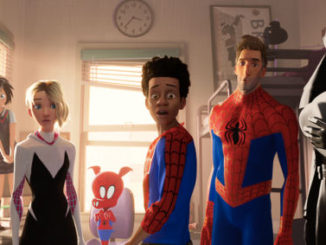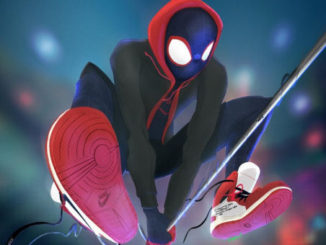Whatever you do, do not let the terribleness of this fall’s Venom discourage you from seeing another Spider-Man related big screen adventure. Because if you do, you will pass on Spider-Man: Into The Spider-verse, one of the best Spider-Man films in the franchise’s sixteen year history as well as the best animated film and possibly the best overall superhero film of the year.
MIles Morales is just trying to be an average teenager from Brooklyn , but that’s hard when your parents have you enrolled in a school for gifted students. Still, he spends time hanging with his uncle, who encourages his more artistic side. While the two are exploring some old abandoned subway catacombs to find a suitable canvas for some of Miles’s graffiti, he is bit by a radioactive spider and soon discovers that he has the powers of a spider, just like New York’s famous superhero Spider-Man. But when Miles is the only witness to Spider-Man’s brutal murder while trying to stop the villainous Kingpin from activating a device that could rip a whole in the fabric of the universe, with the side effect of destroying New York City, he finds himself trying to replace Spider-Man and save the city. Fortunately, he gets some help in the form of some superheroes from nearby parallel worlds who all share similar spider super powers.
What is interesting about Spider-Man: Into The Spider-verse is that the film not only functions as an introduction of Miles Morales to audiences outside of comic book readership who might not be familiar with the character, but also serves as an exploration of the legacy of the character of Spider-Man himself. Nearly everyone is familiar with the story of how Peter Parker first thought to use his new found superpowers for financial gain but turned to superheroics after realizing he inadvertently could have prevented the murder of his Uncle Ben. Heck, even those who aren’t all that familiar with the comic book superhero have most likely heard the phrase “With great power comes great responsibility,” which stems from Spider-man’s origin. Outside of Peter Parker, though, all of the other Spider-heroes who Miles meets have variations of that story as well. And it is here that the film show Miles, and the audience, that no matter what circumstances one finds themselves in, one can always rise above them.
This is not just a story about the legacy of Spider-Man. Sad circumstances have made it a story about the legacy of Spider-Man co-creator Stan Lee in a way. If it weren’t for his work in the 1960s during the early days of Marvel Comics superhero boom, the basis of so many of these characters wouldn’t have existed. And the diversity of the Spider-heroes who join up with Miles but all having similar experiences in their pasts that motivate them to become heroes shows the universality of Lee’s characters. As Lee says in his cameo, “The costume always fits.”
Some attention must be given to the film’s animation and production, because it is unlike anything else being done for the big screen right now. With everyone seeming to chase animation powerhouse studio Pixar’s signature style of computer-generated 3D modeled animation, Into The Spider-verse finds a visually interesting medium between that Pixar style and a printed comic book page, retaining a fully dimensional look while bold black lines and Ben-Day dots help to define people and objects. The visual link back to comic books is further accentuated with the occasional use of thought balloons and text boxes that serve to give us certain characters’ interior monologues.
The design and look of the film is modern and of the moment, without feeling as if it is faddish and could age poorly. The animation itself often has an energy and a vitality that helps to propel the story along.
And the attention to detail in differentiating the Miles Morales’s world versus our own is impressive. Sure background things like a sign for Koca-Soda instead of Coca-Cola or the Red Man Group instead of Blue Man Group do the major lifting in creating a New York City just a little off center from our own. But when you realize that the city’s police identify themselves as “PDNY” instead of the “NYPD” used in our reality, you see how meticulous the filmmakers were in their creation.




